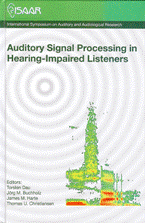Speech intelligibility in simulated acoustic conditions for normal hearing and hearing-impaired listeners
Abstract
The possibility to predict speech intelligibility scores for hearing-impaired lis- teners from the audiogram depends on the variability of these scores among listeners. It is not clear how large this variability is when speech intelligibility is assessed in complex listening environments for groups of hearing-impaired listeners with different hearing loss con gurations. Therefore, speech reception thresholds (SRT) were measured in this study for different groups of hearing-impaired listeners in simulated acoustic environments. The variability among hearing-impaired listeners with a mild (group 1) or steeply sloping (group 2) sensorineural hearing loss was small for all configurations whereas hearing-impaired with a moderately sloping (group 3) or at moderate to severe (group 4) sensorineural hearing loss showed considerable variability of the SRT. Spatial separation of the signal and the interferer increased the variability for the listeners from group 3. An average SRT with a small standard deviation could not be obtained for group 3 and 4 and speech intelligibility prediction from the audiogram is therefore not possible for these groups with the necessary accuracy.
References
IEC (1970) IEC 318. “An IEC artificial ear, of the wide band type, for the calibration of earphones used in audiometry,” International Electrotechnical Commission, Geneva, Switzerland.
IEC (1996) IEC 60318-2. “Devices for measurement of earphones – Part 2: An interim acoustic coupler for the calibration of audiometric earphones in the extended high-frequency range,” International Electrotechnical Commission, Geneva, Switzerland.
ISO (2004), ISO 389-8. “Acoustics – Reference zero for the calibration of audiometric equipment – Part 8. Reference equivalent threshold sound pressure levels for pure tones and circumaural earphones,” International Standardization Organization, Geneva, Switzerland.
Marshall, L., and Bacon, S. P. (1981). “Prediction of speech discrimination scores from audiometric data,” Ear and Hearing, 2, 148-155.
Nabelek, A. K., and Pickett, J. M. (1974). “Monaural and binaural speech perception through hearing aids under noise and reverberation with normal and hearing-impaired listeners,” Journal of Speech and Hearing Research, 17, 724-739.
Odeon Room Acoustic Software (2005) Version 8.0, www.odeon.dk.
Plomp, R. (1986). “A signal-to-noise ratio model for the speech reception threshold of the hearing impaired,” Journal of Speech and Hearing Research, 29, 146-154.
Wagener, K., Brand, T., Kühnel, V., and Kollmeier, B. (1999a). “Entwicklung und Evaluation eines Satztests für die deutsche Sprache. I. Design des Oldenburger Satztests,” Zeitschrift für Audiologie/Audiological Acoustics, 38, 4-14.
Wagener, K., Brand, T., Kühnel, V., and Kollmeier, B. (1999b). “Entwicklung und Evaluation eines Satztests für die deutsche Sprache. II. Optimierung des Oldenburger Satztests,” Zeitschrift für Audiologie/Audiological Acoustics, 38, 44-56.
Wagener, K., Brand, T., Kühnel, V., and Kollmeier, B. (1999c). “Entwicklung und Eva- luation eines Satztests für die deutsche Sprache. III. Evaluation des Oldenburger Satztests,” Zeitschrift für Audiologie/Audiological Acoustics, 38, 86-95.
Wagener, K., (2003). “Design, optimization and evaluation of a Danish sentence test in noise,” International Journal of Audiology, 42, 10-17.
Yokiosa, P., and Thornton, A. (1980). “Predicting speech discrimination from audiometric thresholds,” Journal of Speech and Hearing Research, 23, 814-827.
Additional Files
Published
How to Cite
Issue
Section
License
Authors who publish with this journal agree to the following terms:
a. Authors retain copyright* and grant the journal right of first publication with the work simultaneously licensed under a Creative Commons Attribution License that allows others to share the work with an acknowledgement of the work's authorship and initial publication in this journal.
b. Authors are able to enter into separate, additional contractual arrangements for the non-exclusive distribution of the journal's published version of the work (e.g., post it to an institutional repository or publish it in a book), with an acknowledgement of its initial publication in this journal.
c. Authors are permitted and encouraged to post their work online (e.g., in institutional repositories or on their website) prior to and during the submission process, as it can lead to productive exchanges, as well as earlier and greater citation of published work (See The Effect of Open Access).
*From the 2017 issue onward. The Danavox Jubilee Foundation owns the copyright of all articles published in the 1969-2015 issues. However, authors are still allowed to share the work with an acknowledgement of the work's authorship and initial publication in this journal.


